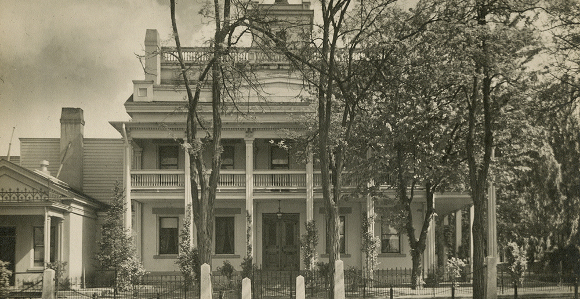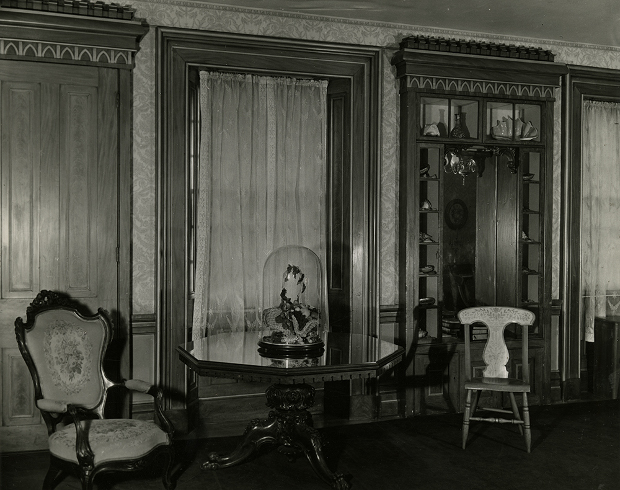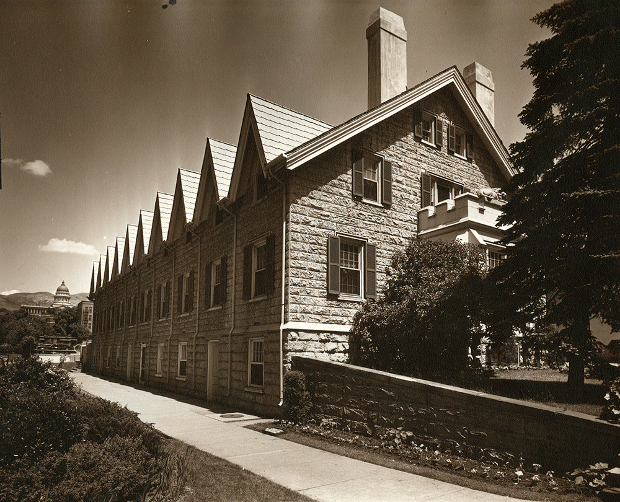“Little-Told History” of Beehive House and Lion House Comes to Life at Symposium
Contributed By R. Scott Lloyd, Church News staff writer

The Beehive House as it looked when it became a boarding home for young women working in Salt Lake City beginning in 1920.
Article Highlights
- Originally the residence of Utah’s governor, the Beehive House later became a boarding home for working women.
- First a residence and later housing a university, the Lion House became a social center for young women.
“[Living in the Beehive House] really strengthened my testimony. It taught me that the Lord loved me and cared for me.” —Sister Janet Hales, former Beehive House resident
Related Links
The “little-told history” of the association between the young women of the Church and the Beehive House and Lion House in downtown Salt Lake City was the subject of a lecture on March 3 at the Church History Symposium at Brigham Young University.
Brittany Chapman Nash, a historian with the Church History Library, and Emily Utt, a historic sites curator with the Church History Department, were the presenters. They spoke of the later use of the Beehive and Lion Houses. Originally residences for President Brigham Young and his family and located next to each other, the two houses became respectively a boarding home and social center for young Latter-day Saint women who were single and working or getting an education in Salt Lake City in the earlier part of the 20th century.
Sister Utt said the Beehive House was completed in 1854 and was designed as the official governor’s residence. President Young was the first territorial governor in Utah.
She said the Lion House was constructed in 1856 to house a large number of President Young’s family members, and that it was intended as a private residence, not a home to receive dignitaries, unlike the Beehive House.
“Brigham Young deeded the Beehive House to Lucy Decker Young before his death, and she lived in the home until 1888,” Sister Utt said. “The house was sold to John W. Young, son of Brigham and Mary Ann Angell Young, who began a major addition and renovation project. The Beehive House more than doubled in size between John W. Young’s project and later changes made by John Beck.”
Plans to turn the structure into a hotel never materialized, and in 1900 Church President Lorenzo Snow moved into it. He was succeeded by President Joseph F. Smith, who lived in the home until his death in 1918.
“The Beehive House was vacant for about two years until the function we are discussing today began, that of a boarding home for Latter-day Saint young women,” Sister Utt said.
Sister Nash said there was a movement nationwide to safeguard young women working in urban areas.
“The concept of having a young women’s boarding home arose out of several factors, the first being the physical well-being of the young woman; the second was her moral or spiritual well-being.”
She added, “By 1875, the Young Women’s Christian Association (YWCA) was operating a substantial number of boarding homes in cities for working women. Over the ensuing decades, other religious, racial, and ethnic groups followed suit and created homes for self-supporting young women.”
A “perfect storm of events” made it possible for the Beehive House to become a boarding home for working young women, Sister Nash said. Local leaders of the YWMIA (forerunner to the Young Women organization of the Church) wrote to the general board, suggesting that the facility be used for this purpose after Church President Heber J. Grant declined to move into it following the death of his predecessor, President Smith, thus leaving the structure vacant.
“On April 3, 1920, the Deseret News carried the announcement that the Beehive House would be a ‘home for working girls and those of moderate means who cannot find suitable homes’ and that ‘the spacious pioneer residence’ [was] to be renovated and refurbished,” she said.
Sister Utt noted that the Beehive House was a perfect candidate for a Church-based boarding house, located in the center of downtown Salt Lake City.
“Women living in the house could remain on Church property for the majority of their day if they were attending LDS University or working at the nearby Church Office Building [today called the Church Administration Building] or Bishop’s Building. The large home, with its connections to prophets and its outward architectural appearance, provided a good level of gentility for Latter-day Saint women moving to Salt Lake City. Even better, the house was enormous, meaning it could house a large number of women without feeling too cramped.”
Sister Nash quoted Janet Hales, one of the last Beehive House residents, who roomed there in the 1950s.
“The highlight of her experience living in the Beehive House,” Sister Nash said, “were the friends she made, and pages of her scrapbook are filled with memories of parties, friends, and staff at the boarding home. Living in the Beehive House ‘really strengthened my testimony,’ Sister Hales reflected. ‘It taught me that the Lord loved me and cared for me.’”
It was initially hoped that the Beehive House would serve as a social center for young women who did not live there; that role would come to be occupied by the adjacent Lion House.
“The Lion House has always had special significance to the Young Women organization, because … that is where the Young Ladies’ Department of the Ladies’ Cooperative Retrenchment Association was founded in 1870, now, of course, called Young Women,” Sister Nash recounted. “In 1931, 61 years after the creation of the association, the Lion House was soon to be inextricably tied to the Young Women program like never before, a tie that is little-remembered today.” At that time, LDS University was closing and the Lion House would no longer be needed for domestic science and other courses offered there.
“The YLMIA approached the First Presidency and requested that the Lion House become a social center for girls and women,” Sister Nash said. “Patrons could rent rooms for social events, take classes, join clubs, and have a ‘homey home’ in which to study, work, and visit.”
The Church leaders in December 1931 approved it for that purpose, so long as it could sustain itself financially.
By the 1960s expanding college campuses and changing demographics of college students, “coupled with the Church’s renewed emphasis on women not working outside the home, spelled the demise of the Beehive House boarding home,” Sister Utt explained.
The structure was tentatively scheduled for demolition, but Brigham Young’s descendants intervened to keep it from becoming the site of a parking lot, she said.
The buildings were renovated and restored.
The Beehive House reopened on Pioneer Day, July 24, 1961, as a visitor attraction, giving information about its original use as a residence for President Young’s family.
The Lion House reopened in 1968 and is today a restaurant and reception center.
“If now, the Lion and Beehive Houses celebrate masculinity, power, and leadership, at one time, they symbolized femininity, hominess, morality, education, and wholesome recreation,” Sister Nash concluded. “It is important that that side of the story be told and remembered.”

Parlor of the Lion House in the 1930s. Photo courtesy of the Church History Library.

Ruth May Fox celebrating her 90th birthday in the parlor of the Beehive House. She was the third general president of the Young Women organization of the Church from 1929 to 1937. Photo courtesy of the Church History Library.
Matron's room at the Beehive House during the time it was a boarding home for young LDS women working in Salt Lake City. Photo courtesy of the Church History Library.

Lion House at the time it was being used as a social center for girls and women beginning in 1931. Photo courtesy of the Church History Library.

Lion House when it was being used by LDS University (Latter-day Saints College). The Salt Lake Temple can be seen in the background because the Hotel Utah and Church Administration Building had not been built yet. Photo courtesy of the Church History Library.

Beehive House as it looked when it became a boarding home for young women working in Salt Lake City beginning in 1920. Photo courtesy of the Church History Library.

Lion House at the time it was being used as a social center for girls and women beginning in 1931. Photo courtesy of the Church History Library.

Members of the LDS Male Chorus at a party at the Lion House in 1945. Photo courtesy of the Church History Library.

Banquet attended by Church President George Albert Smith, foreground, illustrates the Lion House's use as a social center that catered home-style cooking. Photo courtesy of the Church History Library.

Brittany Chapman Nash presents a lecture on the little-told association between the Beehive House, the Lion House, and the LDS young women in the early 20th century. Photo by R. Scott Lloyd.

Emily Utt presents a lecture on the little-told association between the Beehive House, the Lion House, and the LDS young women in the early 20th century. Photo by R. Scott Lloyd.
